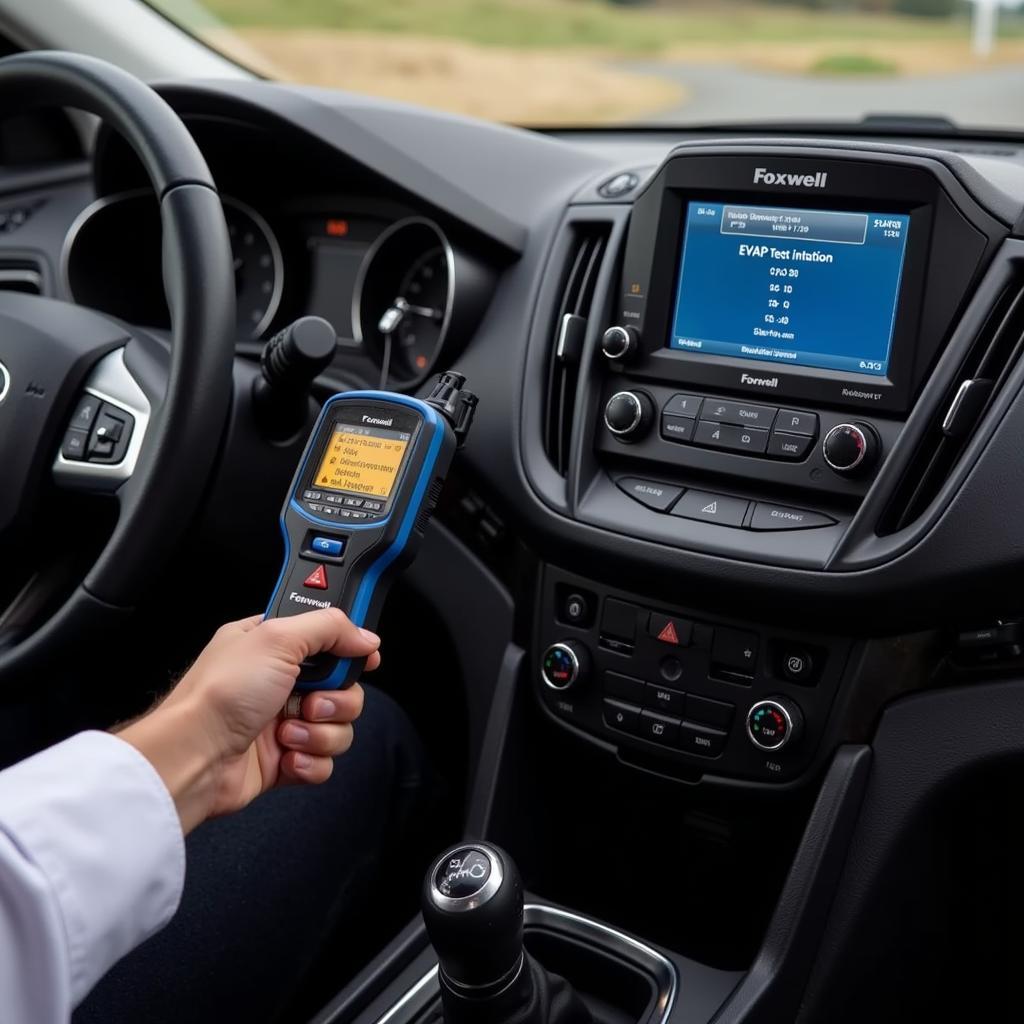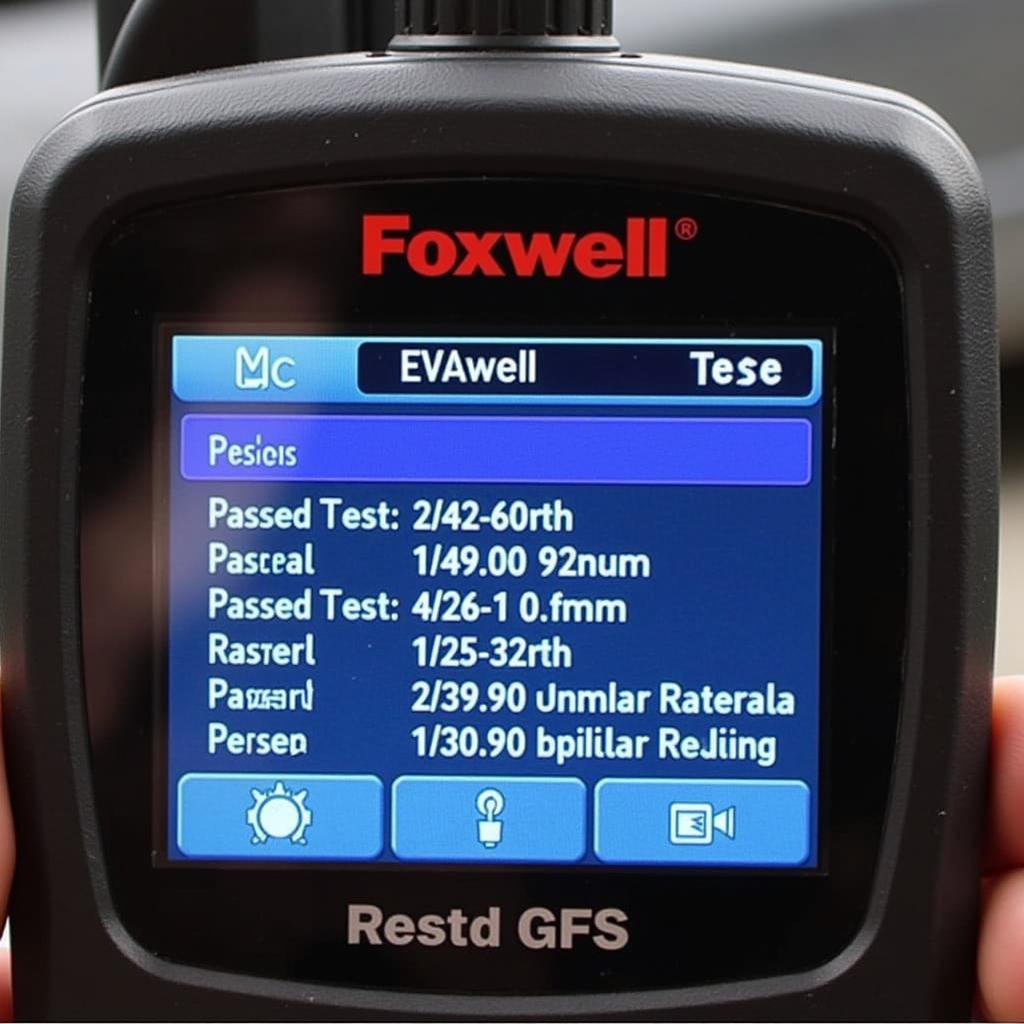The Foxwell Evap Test is a crucial diagnostic procedure for identifying issues within a vehicle’s Evaporative Emission Control System (EVAP). This system is responsible for capturing and storing fuel vapors, preventing them from being released into the atmosphere. A malfunctioning EVAP system can lead to increased emissions, reduced fuel economy, and even trigger the dreaded check engine light. This guide aims to demystify the Foxwell EVAP test, providing car owners, mechanics, and technicians with the knowledge needed to diagnose and address EVAP-related problems effectively.
 Connecting a Foxwell Scanner for EVAP Test
Connecting a Foxwell Scanner for EVAP Test
What is an EVAP System and Why is it Important?
Before delving into the specifics of the Foxwell EVAP test, it’s essential to understand the EVAP system’s function and importance. The EVAP system is a network of components that work together to prevent fuel vapors from escaping into the atmosphere. These vapors, composed of hydrocarbons, contribute to smog and air pollution. The EVAP system captures these vapors in a charcoal canister and then purges them into the engine to be burned during combustion.
A properly functioning EVAP system is crucial for several reasons:
- Environmental Protection: By preventing fuel vapors from escaping, the EVAP system significantly reduces harmful emissions, contributing to cleaner air and a healthier environment.
- Improved Fuel Economy: Capturing and burning fuel vapors instead of releasing them ensures that all fuel is used efficiently, optimizing fuel economy.
- Preventing Fuel Odor: The EVAP system eliminates the strong gasoline smell that can emanate from a vehicle, especially during refueling.
Common EVAP System Problems
The EVAP system, like any other vehicle system, is susceptible to various problems, often indicated by a lit check engine light. Some common EVAP issues include:
- Loose or Damaged Gas Cap: The gas cap seals the fuel tank, preventing vapors from escaping. A loose, damaged, or missing gas cap is a common cause of EVAP leaks.
- Cracked or Disconnected Hoses: The EVAP system relies on a network of hoses to transfer vapors. Cracked, loose, or disconnected hoses can lead to leaks.
- Faulty Purge Valve: The purge valve controls the flow of vapors from the charcoal canister to the engine. A malfunctioning purge valve can disrupt this process, leading to EVAP issues.
- Damaged Charcoal Canister: The charcoal canister stores the fuel vapors. Over time, the canister can become saturated or damaged, hindering its ability to store vapors effectively.
How Does a Foxwell EVAP Test Work?
 Foxwell Scanner Displaying EVAP Test Results
Foxwell Scanner Displaying EVAP Test Results
A Foxwell EVAP test utilizes a specialized diagnostic scanner, like the ones offered by Foxwell, to test the integrity of the EVAP system. Here’s a simplified explanation of the process:
- Connection and Initialization: The Foxwell scanner connects to the vehicle’s OBD-II port, allowing it to communicate with the vehicle’s computer. The EVAP test is then initiated through the scanner’s menu.
- System Sealing: The scanner commands the EVAP system to seal itself, closing off all vents and valves.
- Pressure or Vacuum Application: The scanner then instructs the EVAP system to either apply pressure or vacuum to the system, depending on the vehicle’s make and model.
- Leak Detection: The scanner monitors the system’s pressure or vacuum over a specific time. If the pressure or vacuum drops beyond acceptable limits, the scanner identifies a leak within the EVAP system.
- Results and Diagnosis: Upon completion of the test, the scanner displays the results, indicating whether the test passed or failed. If a leak is detected, the scanner might provide additional information to help pinpoint the leak’s location.
Benefits of Using a Foxwell Scanner for EVAP Testing
Foxwell scanners are becoming increasingly popular among DIY car enthusiasts and professional mechanics alike for conducting EVAP tests. Here’s why:
- User-Friendly Interface: Foxwell scanners are known for their intuitive interfaces, making them easy to use even for beginners.
- Wide Vehicle Compatibility: Foxwell offers a range of scanners compatible with various vehicle makes and models, ensuring broad coverage.
- Advanced Functionality: Beyond EVAP testing, Foxwell scanners provide a comprehensive suite of diagnostic capabilities, including reading and clearing error codes, viewing live data streams, and performing other system tests.
- Cost-Effective Solution: Compared to visiting a mechanic for EVAP testing, investing in a Foxwell scanner can be a cost-effective solution for car owners who prefer DIY repairs or want to diagnose problems before taking their vehicle to a shop.
You might also be interested in: Foxwell NT301 for Audi A4
Interpreting Foxwell EVAP Test Results
Understanding the results displayed by your Foxwell scanner after an EVAP test is crucial for effective diagnosis and repair. While specific result displays might vary depending on the scanner model, here’s a general interpretation:
- “Pass”: This indicates that the EVAP system successfully held pressure or vacuum throughout the test, suggesting no significant leaks.
- “Fail”: A “Fail” result signals that the system was unable to maintain the required pressure or vacuum, indicating a leak.
- Leak Size: Some scanners might specify the severity of the leak, often categorized as small, medium, or large, providing an idea of the leak’s extent.
- Location Clues: Advanced Foxwell scanners might provide additional data, such as specific fault codes or live sensor readings, that can help pinpoint the leak’s location within the EVAP system.
Troubleshooting Common EVAP Leak Sources
Once a Foxwell EVAP test confirms a leak, pinpointing the source requires a systematic approach. Here’s a step-by-step guide to troubleshoot common EVAP leak sources:
- Visual Inspection: Begin by visually inspecting all EVAP components, including the gas cap, hoses, and connections, for any visible damage, cracks, or loose fittings. Pay close attention to areas around the fuel tank, charcoal canister, and purge valve.
- Gas Cap Check: Ensure the gas cap is tightly secured and the seal is intact. A simple way to check for a loose gas cap is to listen for a hissing sound while the engine is running.
- Smoke Test: If the visual inspection doesn’t reveal the leak, consider performing a smoke test. This involves injecting non-toxic smoke into the EVAP system. The escaping smoke will pinpoint the leak’s location.
- Component Testing: If the leak is traced back to specific components like the purge valve or charcoal canister, these components can be tested individually for proper function using a multimeter or other specialized tools.
For car owners who are not comfortable performing these diagnostic procedures, it’s always advisable to seek assistance from a qualified mechanic, especially if the leak’s source remains elusive.
Have you considered the: Foxwell NT301 Konnwei 850?
Tips for Maintaining a Healthy EVAP System
Preventing EVAP system issues is always better than dealing with repairs. Here are some tips to maintain a healthy EVAP system:
- Regular Gas Cap Checks: Make it a habit to check your gas cap regularly for tightness and any signs of damage. Replace a worn-out or damaged gas cap promptly.
- Timely Inspections: During routine maintenance checks, ask your mechanic to inspect the EVAP system, including hoses and connections, for any signs of wear and tear.
- Refueling Practices: Avoid overfilling your gas tank as it can damage the EVAP system. Stop fueling when the pump automatically shuts off.
Conclusion
The Foxwell EVAP test provides an effective means of diagnosing EVAP system leaks, ensuring your vehicle operates efficiently and with minimal environmental impact. Understanding the EVAP system, utilizing a Foxwell scanner’s capabilities, and adopting preventive maintenance practices can save you from costly repairs and contribute to a cleaner environment.
For any further assistance or guidance regarding Foxwell scanners and EVAP system diagnosis, feel free to reach out to ScanToolUS at +1 (641) 206-8880 or visit our office at 1615 S Laramie Ave, Cicero, IL 60804, USA.
